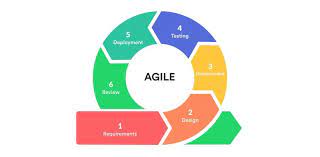The Power of Agile Software Development
Agile software development has revolutionized the way software projects are executed, delivering greater flexibility, efficiency, and customer satisfaction. Unlike traditional waterfall methodologies, agile focuses on iterative and incremental development, allowing teams to adapt to changing requirements and deliver value quickly.
Key Principles of Agile
Agile is guided by several key principles that shape its approach:
- Customer Collaboration: Agile emphasizes close collaboration with customers throughout the development process to ensure their needs are met.
- Iterative Development: Projects are broken down into small iterations or sprints, allowing for continuous feedback and improvement.
- Adaptability: Agile teams are flexible and responsive to change, enabling them to adjust priorities and requirements as needed.
Benefits of Agile Software Development
The adoption of agile methodologies offers numerous benefits to both development teams and businesses:
- Rapid Delivery: Agile enables faster delivery of working software through shorter development cycles.
- Improved Quality: Continuous testing and feedback loops result in higher-quality products that better meet customer expectations.
- Enhanced Collaboration: Cross-functional teams collaborate closely, fostering innovation and shared ownership of project outcomes.
Challenges of Implementing Agile
While agile brings many advantages, it also presents challenges that organizations must address:
- Cultural Shift: Adopting agile requires a cultural shift towards collaboration, transparency, and adaptability within the organization.
- Resource Allocation: Proper allocation of resources and alignment with business goals is crucial for successful agile implementation.
- Risk Management: Managing risks in a dynamic environment where requirements evolve can be challenging without proper risk mitigation strategies in place.
In Conclusion
The power of agile software development lies in its ability to deliver value quickly, respond to change effectively, and foster collaboration among team members. By embracing agile methodologies, organizations can stay competitive in today’s fast-paced digital landscape and meet the evolving needs of their customers with confidence.
Understanding Agile Software: Key Questions Answered
- What are the 4 types of Agile?
- What is Agile in simple words?
- What is an example of Agile software?
- Is Agile same as Jira?
- Which Agile tool is best?
- What is the most popular Agile tool?
- What is Agile vs Scrum?
What are the 4 types of Agile?
In the realm of Agile software development, there are four commonly recognized types of Agile methodologies: Scrum, Kanban, Lean, and Extreme Programming (XP). Each type has its own unique approach and set of practices that guide the development process. Scrum emphasizes iterative development within fixed timeframes called sprints, while Kanban focuses on visualizing workflow and limiting work in progress. Lean aims to eliminate waste and optimize efficiency, and XP promotes practices such as pair programming and test-driven development to ensure high-quality software delivery. Understanding the distinctions among these Agile types can help teams choose the most suitable methodology for their projects.
What is Agile in simple words?
Agile, in simple terms, is a modern approach to software development that emphasizes flexibility, collaboration, and continuous improvement. Instead of following a rigid plan from start to finish, agile teams work in short iterations or sprints to deliver working software incrementally. This iterative process allows for frequent feedback from stakeholders, enabling teams to adapt to changing requirements and deliver value quickly. Agile promotes close collaboration among team members and encourages a customer-centric approach to development, ultimately leading to higher-quality products that better meet the needs of end-users.
What is an example of Agile software?
An example of Agile software is Jira, a popular project management tool widely used by software development teams to facilitate Agile practices. Jira allows teams to create and track user stories, manage sprints, prioritize tasks, and collaborate effectively in an iterative and incremental development environment. By leveraging Jira’s flexibility and customization options, teams can adapt to changing requirements, receive real-time feedback, and deliver high-quality software products efficiently in line with Agile principles.
Is Agile same as Jira?
Agile and Jira are not the same; rather, they are related concepts that often go hand in hand. Agile is a software development methodology that emphasizes iterative and incremental development, while Jira is a popular project management tool commonly used to support agile practices. Jira provides features such as sprint planning, backlog management, and issue tracking that align with agile principles, making it a valuable tool for teams practicing agile software development. While Jira can be used to facilitate agile processes, it is important to note that agile itself is a methodology or approach to software development, while Jira is a specific tool that supports the implementation of agile practices within a team or organization.
Which Agile tool is best?
When considering the question of which Agile tool is best, it’s important to recognize that the answer can vary depending on the specific needs and preferences of a team or organization. There is a wide range of Agile tools available in the market, each offering unique features and functionalities to support different aspects of Agile software development. It is recommended for teams to evaluate their requirements, such as project size, budget, collaboration needs, and integration capabilities, before selecting an Agile tool that aligns best with their workflow and goals. Ultimately, the best Agile tool is one that enhances productivity, facilitates communication, and helps streamline the development process for improved project outcomes.
What is the most popular Agile tool?
When it comes to the most popular Agile tool, there are several widely used options in the market that cater to different needs and preferences of Agile teams. Some of the top contenders include Jira, Trello, Asana, and Monday.com. Each tool offers unique features and functionalities designed to streamline Agile project management, enhance collaboration, and improve team productivity. Ultimately, the choice of the most suitable Agile tool depends on factors such as team size, project complexity, budget constraints, and specific requirements of the organization. It is recommended for teams to evaluate various tools based on their individual needs to determine the best fit for their Agile development process.
What is Agile vs Scrum?
Agile and Scrum are often used interchangeably, but they represent different concepts in the realm of software development. Agile is a broader methodology that emphasizes flexibility, collaboration, and iterative development to deliver value to customers efficiently. On the other hand, Scrum is a specific framework within the Agile methodology that provides a structured approach to managing and executing projects. While Agile sets the principles and values for software development, Scrum offers concrete guidelines on how to implement those principles through roles, events, and artifacts. In essence, Agile is the overarching philosophy, while Scrum is a specific implementation of Agile practices.




